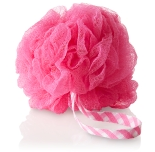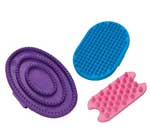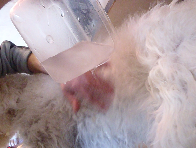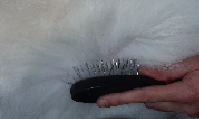Bathing Your Pet
Why bath a dog?
The number one reason for bathing your dog is they get dirty and smelly.
There’s no two ways about it. Some dogs smell worse than others and some
get smellier faster.
So, when they smell rather doggy, just toss them (gently of course) into the tub, soap them up and pour water from the tub over them a couple of times to rinse. Right?
I just don’t think so.
There’s a reason why it takes a groomer longer than you do.
Groomers clean your pet properly and thoroughly.
How often is too often?
Depending on the shampoo you use, will dictate how often to wash.
A hypo-allergenic shampoo contains no soap, and will be gentle and less likely to strip the oils from the coat.
A general, cheaply priced shampoo, well, it’ll damage the coat and skin. Low quality shampoos are not meant for frequent bathing.
A shampoo that is made for frequent bathing, allows you the option of washing your dog often, say every two-three weeks, safely keeping him clean without stripping the natural oils from the fur.
Think about it, people who show their dogs for a living are in dog shows every weekend. They scrub the mutts more frequently than the average pet. Professional breeders and handlers are not going to use a product that may damage the fur through frequent bathing and lessen the chance of winning.
Obviously, they use a gentle high quality shampoo.
So if you plan on bathing your dog often, look for a shampoo that is meant for frequent use.
Talk to your groomer for suggestions on different brands available.
Tools
Hose
Sprayer attached to hose
Shampoo
Conditioner (optional)
Sponge
Rubber brush
Plastic slicker
Towel
Dryer (optional depending on the dog)
Have everything out and ready within an arm’s length to make grabbing it easier. Thoroughly brush Rover before the bathing. Use warm water. The water should be just warmer than your body temperature. Water too cold or too hot will make bathing more difficult. Always be aware of the temperature!
How to bath
1. Soak the dog, thoroughly, except for the head. Get that water through the whole coat, not just run the water on top of the dog. Move the sprayer through the coat against the skin.
2. If you have shampoo that is thick, mix it with a bit of water to allow easy spreading throughout the fur. You can use anything that will move the shampoo easily, a sponge, a netted shower gauze or just your hands.


3. Scrub the dog with your fingers. If you have a dog that doesn’t matt easily, you can use a rubber scrubby

to work the shampoo in while giving your canine a good rub down.
4. Using a slicker brush with plastic bristles, brush the coat while soapy. By brushing in the bath, you straighten the coat out and lessen the chance of matts forming. You also remove shedding hair easily as well as excess shampoo, which makes rinsing easier.
5. Starting on the back, rinse the dog with clean water. Holding the shower head close to the skin slowly move it back and forth from neck to butt, moving down the side of the body until you run out of body. Move the shower head back to the spine and go down each leg. Rinse each part of the dog until the water runs clear of any shampoo. Make sure to rinse the feet last.
6. Repeat the above method with a second shampoo or conditioner if required.
The Head and Face
It is my suggestion to wet and wash the head last.
After you have the body all soaped up and ready to rinse, begin the process of bathing the head.
The first step is to stuff cotton balls in the ears. This is to avoid getting excess water in the ear canal. If water enters the ear canal, there is a high probability that your pup will develop an ear infection. You may have to split a cotton ball in two if your canine has small ears. You may also need to use large cotton balls or a make-up pad if Fido has a large ear canal.
Try to hold the head so the nose is pointing down and soak the head either with a hose held closely on the top of the head or with a bucket.
By holding the head in a down position, the water will run off the nose rather than in it.
Scrub shampoo into the head, face and ears. If he tries to shake, simply hold his nose gently to prevent this. Hold the nose pointing down, rinse well, and proceed to finish the rest of the body.
Dogs hate having a wet face. By leaving the head and face for last, you can reduce the amount of shaking he will do. Have a few cotton balls ready as you may have to replace them a few times if he shakes them out. Always check after the bath if the cotton balls have been shaken free, if not, just pull them out.
Rinsing Without A Shower Head
Using a shower head or anything that will shoot out a spray is the best; however, not everyone has one.
Many owners bath their pup in a sink or tub full of water.There is no way that you can continually rinse him from the water he is sitting in, which is getting soapier, and expect to get the shampoo out.
You cannot get a thorough rinse using this method.
So, what’s a little shampoo left in the fur going to do?
It’s going to make your dog itchy. It’s going to cause easier matting. He will get dirty faster as the shampoo left on, prevents the free flow of natural oils from the skin by leaving a film on the hair and plugging pores on the skin.
Throw on some conditioner and you’ll have a real mess.
1. You can fill the sink or tub with water and place dog in it. Scoop up water in a plastic glass or bucket and totally soak him. You will have to lift up the fur and pour water on each section.

2. Follow steps 2-4 above.
3. Drain water from sink or tub.
4. Starting from the top of canine, rinse each section of the fur.

Move your hands through the fur quickly as you pour clean water through the fur to help move the shampoo off the fur.

5. Keep rinsing until each section is free of shampoo or conditioner.
6. In order to get a complete rinse, each bucket or glassful, must be clean water.
Before towel drying your four legged wet wonder, run your hands through the fur to feel for any missed shampoo or conditioner.
Drying
While the wet one is still in the tub, squeeze water out of the fur.
For short/medium haired mutts vigorously rub towel over the dog. If you have a big mutt, you may need 2-3 towels.
For Long haired pups, that matt easily press and squeeze the pup with a thick towel to soak up water. Rubbing the fur can tangle it and (sigh) cause matts.
When you’ve gotten as much water off the fur as you can, let the mongrel run around for 20-30 minutes to air dry.
Now, you have some choices here.
If it’s a nice day and you have a short haired dog like a lab or Shepard, you can let them dry in the sun. When they are dry, brush them, as the warm water will have loosened up fur making it easy to brush out.
If you have a canine sporting medium-long hair:
1. Prop up or have someone hold your hair dryer, set on medium and dry each section, using the same method you use to brush before bathing

Drying with this method, completely dries the dog, removes any loose coat and straightens any tangles that could turn into matts. Constantly check the temperature of the area of skin and fur exposed to the dryer to prevent burns.
What If?
Fluffy comes in from rolling in a mud puddle?
If you have a high maintenance grooming breed or a pup that easily matts, let the mud dry, brush, then bath.
My Princess just met a skunk!
Contain ‘Stinky” either outside or in the bathroom, get your skunk formula ready. ready. Get your tools ready, de-skunk first then, bath as above. If you brush the fur that has been skunked, you will spread the skunk oil throughout the dog.
Skunked dogs are the exception to the rule of brushing before bathing. The main priority is to de-skunk the pet and hope for the best.
Brushing while the dog is soapy with dog shampoo, after the de-skunkng formula, is better than not brushing at all.
Rover only has a couple matts.
Rover may only have a couple matts, but if you don’t brush the matts out as well as the rest of Rover before washing, you may wind up with more than a couple matts after you’re done. Dogs’ fur is not like human hair. Our hair is often easier to de-tangle while damp, tangles on a canine will tighten and become impossible to brush out.
Fido has tar or sticky things stuck to his feet.
Soak the tar in Coke for about 5 minutes. Scrub the tar off or comb it out, wash the feet with dog shampoo. Coke helps remove tar.
For sticky things from the trees in spring: Rub some shampoo or dish soap on the sticky thing and comb them out. Cornstarch is another excellent way to remove sticky things. Rub the cornstarch into the sticky thing and around the fur, leave for 30 sec and comb out. The sticky thing will slide out.
Mable is covered in oil!
If your pup or cat has been in contact with motor oil, I hate to say this, but Dawn dish soap is the gentlest to use, if you can’t get an animal degreaser. Yes the commercials are true, Dawn dish soap is used to wash the wildlife.
FEISTY FELINES
It is a common misconception that cats clean themselves. They clean their fur, brush their fur (feel a cats’ tongue, it’s a like a brush), straighten out their fur, but they don’t clean down to the skin.
That being said, if the feline keeps its fur maintained, very little dirt gets close to the skin.
However not all cats are good groomers.
If the fur is un-kept, dirt and grime can easily coat the skin.
Bathing a Cat.
Regular exposure from kitten hood, makes bathing a lot easier. If your cat has not been exposed to a water, be fast.
Before the wet deed, brush thoroughly.
Put a cat harness on the cat so you can hold onto it rather than trying to hold onto a wet, soapy ball of fur and fangs.
Wet cat. Shampoo as fast as you can. Rinse as fast as you can.
Now, if you are terrified of getting your arms shredded, wear a long sleeved, thick jacket, a jean jacket works. Or wrap your fore-arms in towels and tape them in place.
Puss Puss will try to get away from the water, if you are in the way, you will get scratched.
If, your cat is still acknowledging your existence after the wet adventure, you can dry her the same way as the canines above. Just makes sure the cat doesn’t get burned by the warm air of the dryer.
Good luck and happy bathing! book an appointment
